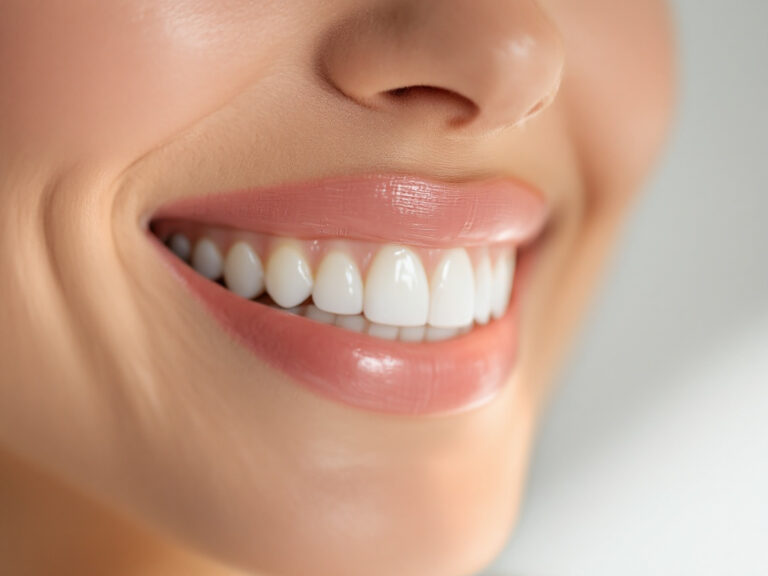If you’ve ever winced at a sip of hot coffee or shivered at a bite of ice cream, you’re familiar with tooth sensitivity. Also known as dentin hypersensitivity, this condition can affect daily habits and enjoyment of your favorite foods. In fact, about one in eight people experience sensitive teeth when they visit the dentist [1], and nearly 40 percent of adults report some degree of discomfort [2]. When you’re seeking an effective tooth sensitivity treatment, understanding the causes, the at-home and professional options, and the preventive steps you can take will empower you to keep your smile comfortable and healthy.
In this guide, you’ll discover:
- What causes sensitive teeth and how to identify the triggers
- At-home relief options you can try today
- Professional care avenues for lasting results
- Preventive strategies to protect your enamel
- When to seek dental attention
- How Belmont Dental can support your smile
By the end, you’ll have a clear roadmap for addressing tooth sensitivity, tailored to your needs and lifestyle.
Understanding tooth sensitivity
Your teeth have a hard outer layer called enamel that protects the softer dentin underneath. Dentin contains microscopic tubules that connect directly to the nerve at the tooth’s core. When enamel wears down or your gums recede, these tubules allow temperature shifts, acids and debris to reach the nerve, causing a sharp, transient pain known as dentin hypersensitivity.
Temperature changes are common triggers—ice-cold water and steaming coffee alike can set off that jolt. Sweet, sour or acidic foods may also provoke discomfort. Brushing too hard with an abrasive toothbrush can exacerbate enamel loss, making routine oral care itself painful.
Furthermore, sensitive teeth can indicate deeper problems. Cavities, cracked teeth or gum disease all expose dentin and heighten sensitivity. If you ignore persistent aches, you risk more serious issues like decay or infection [3]. Understanding how tooth sensitivity develops is the first step toward choosing an effective treatment plan.
Identifying common causes
Several factors contribute to exposed dentin and increased sensitivity. Pinpointing the root cause helps you and your dentist select the most effective approach.
- Enamel erosion: Acidic foods, sodas or fruit juices can gradually wear down enamel, leaving dentin vulnerable [4].
- Gum recession: Brushing too hard or periodontal disease can pull gums away from the tooth, exposing the cementum and root surface that lack protective enamel.
- Dental cavities and cracks: Untreated decay, chips or fractures create pathways for stimuli to reach the nerve.
- Worn fillings: Old or ill-fitting restorations can shrink or break, revealing sensitive tooth structure beneath.
- Gum disease: Inflammation and infection damage gum tissue and may lead to recession.
- Teeth whitening: Professional and over-the-counter bleaching often causes temporary sensitivity by dehydrating dentin tubules [2].
- Bruxism (teeth grinding): Clenching and grinding apply excessive force to teeth, increasing the risk of enamel wear and cracks.
- Aggressive brushing: Using a hard-bristled brush or scrubbing vigorously strips enamel and irritates gums.
Once you recognize which factors affect your oral health, you can tailor your tooth sensitivity treatment plan and make lifestyle adjustments to protect your smile.
Exploring at-home relief
While professional care offers long-term solutions, many people find immediate comfort through simple home treatments. These methods can form the foundation of your day-to-day routine and complement in-office procedures.
Desensitizing toothpaste
Toothpastes formulated for sensitive teeth contain active agents such as potassium nitrate or stannous fluoride. These compounds block the transmission of pain signals from the surface of your tooth to the nerve.
To use:
- Apply a pea-sized amount on a soft-bristled toothbrush.
- Brush gently in circular motions for two minutes.
- Rinse and spit, avoiding vigorous rinsing to let ingredients work.
- Repeat twice daily.
You may notice reduced sensitivity in two to four weeks. Continue use even after relief to maintain protection.
Fluoride mouth rinses
Fluoride helps remineralize enamel and can plug exposed tubules. Over-the-counter fluoride rinses are convenient, but your dentist may recommend a higher-concentration formulation for greater effect.
Usage tips:
- Swish once a day for 60 seconds.
- Avoid eating or drinking for 30 minutes afterward.
- Do not swallow.
Tip: A mild hydrogen peroxide rinse—mix one part 3% hydrogen peroxide with two parts water—can offer additional antibacterial benefits and soothe irritated gums [5]. Always spit out and never swallow.
Natural and dietary methods
You can also turn to natural ingredients that have pain-relieving or anti-inflammatory properties.
- Clove oil: Apply one drop of clove oil or clove gel to the sensitive area with a cotton swab. Clove offers analgesic and antimicrobial effects [1].
- Guava leaf extract: Chew fresh guava leaves for five minutes or apply a topical gel to benefit from flavonoids that may reduce pain [1].
- Turmeric paste: Mix half a teaspoon of turmeric powder with enough water to form a paste. Apply on the gums and sensitive tooth for five to ten minutes, then rinse.
- Green tea: Drink green tea regularly. Its antioxidants can support gum health and may reduce sensitivity over time.
- Honey rinse: Stir a tablespoon of honey into warm water and swish for one minute. Honey’s antibacterial properties can help maintain a healthy oral environment.
- Oil pulling: Swish a tablespoon of coconut or sesame oil in your mouth for 10–15 minutes, then spit out. Some studies suggest oil pulling may reduce gingivitis-related sensitivity [1].
While these home remedies can provide short-term comfort, they may not address deeper issues. If sensitivity persists beyond a few weeks, professional care can offer more lasting results.
Technique adjustments
Modifying your brushing and eating habits can minimize stress on sensitive teeth:
- Use a soft-bristled or sensitivity-specific electric toothbrush.
- Brush with gentle pressure—imagine holding an egg without cracking it.
- Avoid brushing immediately after acidic foods; wait 30 minutes to prevent enamel abrasion.
- Chew on the opposite side when eating very hot, cold or hard foods.
- Drink acidic or cold beverages through a straw to reduce contact with sensitive surfaces.
Incorporate these modifications alongside your desensitizing regimen to enhance daily comfort.
Accessing professional care
If home remedies and over-the-counter products don’t bring adequate relief, professional intervention can address deeper sources of sensitivity and provide faster, more durable results.
Diagnostic assessments
Your dentist will begin with a thorough examination to identify the precise cause of your sensitivity. This process may include:
- Visual and tactile inspection of enamel, fillings and restorations
- Gentle air blasts or cold water stimuli to map sensitive areas
- The Schiff Cold Air Sensitivity Scale and visual analogue scale (VAS) to quantify discomfort [6]
- Dental X-rays to detect cavities or cracks not visible to the naked eye
Accurate diagnosis ensures your treatment plan targets the correct root cause.
In-office fluoride treatments
When you need higher concentrations than retail products, your dentist can apply professional-grade fluoride varnish or gel directly to sensitive teeth. This treatment:
- Promotes enamel remineralization
- Quickly occludes dentin tubules
- Lasts for several months, depending on oral care habits
Ask about fluoride treatment for adults if you are experiencing persistent sensitivity despite home care.
Sealants, bonding and restorations
For areas where roots are exposed or enamel is compromised, protective coatings can shield underlying dentin:
| Treatment | Description |
|---|---|
| Dental sealants | A tooth-colored resin covers exposed root surfaces, preventing stimuli from entering the tubules [7] |
| Composite bonding | A durable composite material repairs chips, cracks and worn fillings to seal sensitive regions |
| Inlay or onlay restorations | Custom-fabricated pieces restore large cavities and protect the tooth’s structure |
In addition, regular professional teeth cleaning removes plaque and tartar that can exacerbate gum recession and sensitivity.
Surgical and advanced procedures
In more severe cases, your dentist might recommend:
- Gum graft surgery Transplanting tissue to cover exposed roots and reduce sensitivity. Pair this with ongoing maintenance for lasting results.
- Root canal therapy Removing the nerve when sensitivity indicates irreversible pulp damage—typically a last resort.
- Protective restorations Such as crowns for extensively damaged teeth to restore function and protect dentin.
Your dentist will discuss risks, benefits and insurance coverage to help you make an informed decision.
Preventing future sensitivity
Implementing preventive strategies is crucial to minimize the chance of sensitivity returning. By adjusting your daily habits and maintaining regular dental visits, you can protect your enamel and gum health.
- Schedule a routine dental checkup at least twice a year to catch early signs of enamel wear or gum recession.
- Follow a custom dental hygiene plan designed around your specific risk factors and lifestyle.
- Adopt a gentle brushing routine with a soft-bristled brush and nonabrasive toothpaste.
- Rinse with water after acidic or sugary foods and wait 30 minutes before brushing.
- Wear a mouthguard if you grind or clench, protecting teeth from excessive force.
- Enroll in a preventive dental care plan for sealants, fluoride treatments and targeted monitoring.
Overall, combining these measures with timely professional interventions fosters long-term comfort and resilience against sensitivity.
Recognizing when to seek help
Even with a robust home care routine, certain warning signs call for prompt professional attention. Addressing issues early prevents complications and preserves your tooth structure.
Warning signs
- Sensitivity without an apparent trigger—pain occurs even when you’re not eating or drinking
- Prolonged or escalating discomfort—home remedies fail or pain worsens over days
- Visible tooth damage—new chips, cracks or cavities
- Gum symptoms—receding gums, persistent bleeding or inflammation
- Signs of infection—facial swelling, fever or tender lymph nodes
Scheduling your exam
When you notice any of these signs, take action:
- Book a dental exam appointment promptly.
- Request a comprehensive dental assessment including X-rays and clinical evaluation.
- Ask about an oral cancer screening as part of your overall exam if indicated.
Timely diagnosis not only relieves your discomfort but also prevents more invasive and costly procedures down the road.
Choosing Belmont Dental
At Belmont Dental, we believe in proactive, patient-centered care. We are your partner in achieving a healthy, comfortable smile through:
- Insurance-friendly services Our insurance accepted dental office helps you maximize benefits with transparent pricing.
- Family-focused approach You’ll feel at ease with our gentle dentist for families and child-friendly amenities.
- Comprehensive preventive programs From your new patient dental exam to ongoing checkups, we offer a full spectrum of family dental care services.
- Advanced treatment options Our team delivers in-office procedures, from painless dental cleaning to specialized sensitivity therapies.
- Comfort-focused environment We prioritize your comfort at every visit, ensuring a positive experience.
Ready to banish tooth sensitivity and protect your smile? Schedule your visit online or call to speak with our friendly team and take the first step toward lasting relief.







